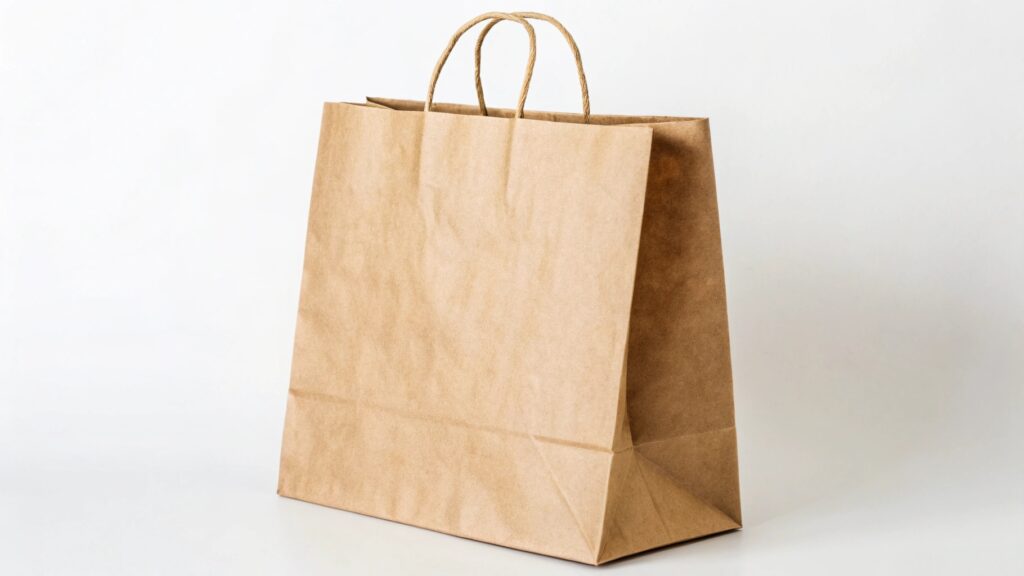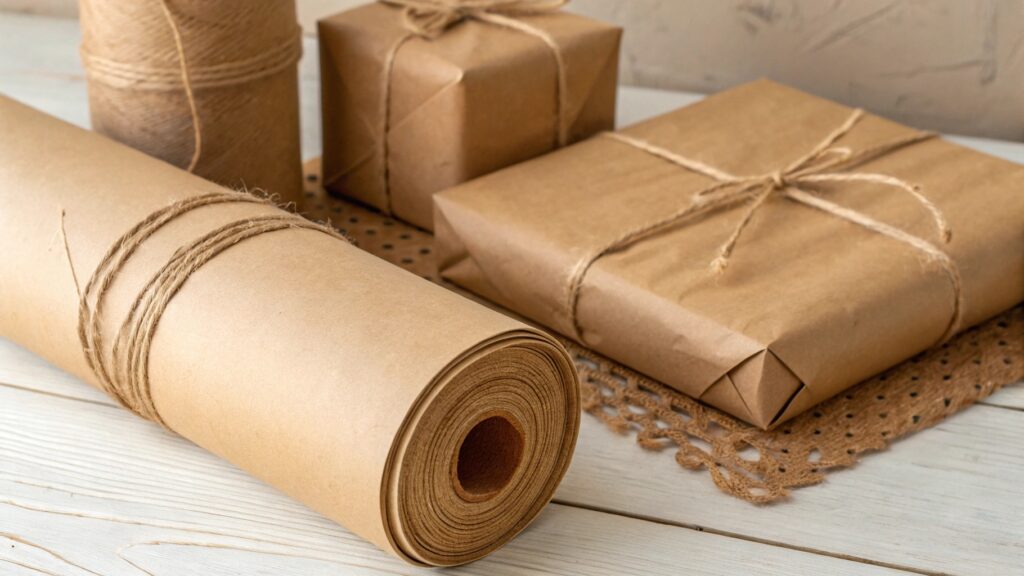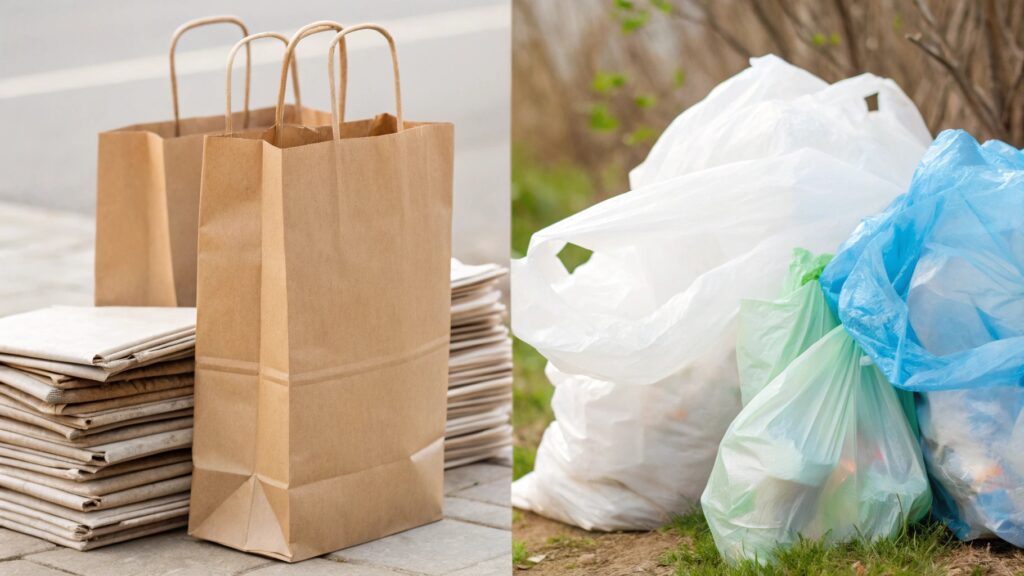Are Kraft Paper Shopping Bags a Good Choice for Your Brand?
Are you looking for packaging that tells your brand's story? Do you want a bag that stands out as eco-friendly and honest? Discover the hidden power of Kraft paper shopping bags.
Kraft paper shopping bags are a good choice because they blend function, minimalism, and brand storytelling. They visually and emotionally communicate a brand’s values like honesty and simplicity, acting as a tactile and visual extension of your brand ethos, making them a strategic choice beyond just sustainability.

Kraft paper shopping bags have become a common sight in stores that care about the environment. But their impact goes much further than just being sustainable. In my view, they bring together function, a simple look, and brand storytelling in a powerful way. I have seen this trend grow rapidly here in Singapore.
Is Kraft paper good for packaging?
Do you wonder if Kraft paper is strong enough for your products? Are you looking for packaging that looks natural and trustworthy? Discover why Kraft paper is an excellent choice for packaging.
Yes, Kraft paper is good for packaging because it is durable, visually appealing, and suggests honesty and simplicity to consumers. Its natural aesthetic cuts through synthetic noise, making it a strategic choice for brands that want to communicate quality and environmental care through their packaging.

While many see Kraft paper bags as just a greener choice than plastic, I believe their true value is in how they visually and emotionally share a brand’s values. The natural, rough texture of Kraft paper suggests honesty and simplicity. These are two qualities that modern shoppers really connect with and see as trustworthy. In a world full of artificial packaging, the natural look of Kraft paper stands out with quiet strength.
Here are reasons why Kraft paper is good for packaging:
- Durability and Strength: Kraft paper1 is made from wood pulp using a chemical process that keeps more of the wood fibers intact. This makes it much stronger than regular paper. It resists tearing and punctures, even when wet. For instance, I have handled shipments where Kraft paper bags, though seemingly light, held surprisingly heavy items without failing.
- Versatility: It can be used for many types of packaging. This includes shopping bags, wrapping paper, corrugated boxes, and even food packaging liners. It comes in different weights and finishes, so brands can choose what fits their product best.
- Printability: Despite its raw texture, Kraft paper takes printing very well. You can print logos, text, and simple graphics clearly on it. This allows for effective branding without needing complex or expensive printing techniques.
- Aesthetic Appeal: Its natural, unbleached brown color gives a rustic, organic, and minimalist look. This aesthetic is highly appealing to consumers who prefer natural products and eco-friendly2 brands. It often makes a product feel more artisanal or authentic.
- Cost-Effectiveness: For large-scale distribution, Kraft paper is lightweight and often more cost-effective to produce and transport compared to other sturdy packaging materials. This balance between practicality and perception is what makes it such a strategic choice.
From years working with both boutique and corporate clients, I have noticed something interesting. Brands that switch to Kraft paper bags often report stronger customer feelings. This is true especially when they add custom printing or thoughtful design. Why? Because the bag does not just carry a product. It strengthens a message: "We care. About the planet. About quality. About every detail." This shows that Kraft paper is not just packaging. It is a visual and touchable part of your brand's core values.
| Aspect | Benefit for Packaging | Impact on Brand Perception |
|---|---|---|
| Strength | Resists tearing, holds heavier items | Reliable, high-quality |
| Aesthetic | Natural, minimalist, authentic look | Trustworthy, eco-conscious, genuine |
| Printability | Clear logos and designs | Professional, attention to detail |
| Versatility | Suitable for various products/uses | Adaptable, modern |
| Cost | Economical for bulk, light for shipping | Efficient, smart choice |
Are paper shopping bags better than plastic?
Are you torn between paper and plastic bags for your business? Do you want to make the most environmentally responsible choice? Understand the complex comparison.
Generally, paper shopping bags are considered better than plastic due to their biodegradability3 and recyclability, which reduce long-term environmental pollution. However, their production requires more energy and water, making reuse crucial for them to be a truly superior choice compared to single-use plastic.

This question is more complex than it first seems. For a long time, paper bags were seen as the clear "good guy" compared to plastic. But the truth is, both have environmental costs. It is about understanding the full picture.
Here's a comparison to help explain why paper bags are often seen as better, but with important considerations:
- Production Impact:
- Paper Bags: Making paper bags uses more energy and water than making plastic bags. It also often needs more trees, though many paper bags use recycled content. The process can release more air pollution than plastic bag production.
- Plastic Bags: Making plastic bags uses less energy and water initially. But plastic is made from fossil fuels, a non-renewable resource.
- Environmental Degradation & Waste:
- Paper Bags: They are biodegradable. This means they break down naturally over time, especially in compost. They are also widely recyclable in most places, which reduces landfill waste. I have seen many recycling programs in Singapore that accept paper bags.
- Plastic Bags: They are not biodegradable. They can take hundreds of years to break down, breaking into smaller microplastic pieces that pollute land and oceans. While some plastics are recyclable, many single-use plastic bags are not easily recycled.
- Reusability:
- Paper Bags: They are less durable than plastic bags. They can tear easily when wet or holding heavy items. This means they are often used once and then thrown away. For paper bags to be truly better, they need to be reused multiple times.
- Plastic Bags: They are more durable for single use but are usually designed to be thrown away quickly.
So, while paper bags have a higher impact during production, their benefits at the end of their life (biodegradability, recyclability) make them a better choice for reducing long-term pollution and waste. The key is to encourage reuse of any bag, whether paper or fabric, to truly lower environmental impact. Brands switching to paper bags should emphasize their reusability.
| Feature | Paper Bags | Plastic Bags |
|---|---|---|
| Production Energy | Higher | Lower (but from fossil fuels) |
| Water Usage | Higher | Lower |
| Biodegradability | Yes, break down naturally | No, break into microplastics |
| Recyclability | Generally good, widely accepted | Limited, often not easily recycled |
| Durability (Single Use) | Lower (tear easily when wet/heavy) | Higher |
| Environmental Pollution | Less long-term pollution, less marine harm | Significant long-term pollution, microplastics |
Are Kraft paper bags eco-friendly?
Do you believe all paper bags are equally green? Are Kraft paper bags truly a sustainable choice? Learn what makes Kraft paper bags eco-friendly and their limitations.
Yes, Kraft paper bags are generally considered eco-friendly due to their natural material, biodegradability, and high recyclability. They are often made from sustainable wood sources and can incorporate recycled content, making them a strong choice for brands prioritizing environmental responsibility over synthetic packaging.

Kraft paper bags are often seen as eco-friendly, and for good reasons. They come from natural materials, can break down naturally, and are easy to recycle. However, it's important to understand the full picture of their environmental impact.
Here's why Kraft paper bags are considered eco-friendly:
- Natural and Renewable Resource: Kraft paper is made from wood pulp, a renewable resource. If the wood comes from sustainably managed forests (e.g., FSC-certified), the environmental impact is reduced.
- Biodegradability: Unlike plastic, Kraft paper naturally breaks down in the environment, returning to the earth without leaving lasting pollution. This is a big plus for reducing landfill waste.
- High Recyclability: Kraft paper is highly recyclable. It can often be recycled multiple times to create new paper products. This reduces the demand for virgin wood pulp and saves resources. Many recycling programs in Singapore accept Kraft paper.
- Often Made with Recycled Content: Many Kraft paper bags include a percentage of post-consumer recycled material. This further reduces their environmental footprint by repurposing waste.
- Lower Toxicity: The Kraft process uses fewer harsh chemicals compared to some other paper-making methods. This makes the resulting paper less toxic.
However, it is important to note that "eco-friendly" is not always absolute. The production of any paper, including Kraft, still requires energy and water. It also produces emissions. Therefore, the most eco-friendly Kraft paper bag is one that is reused multiple times before being recycled. This extends its life and lowers its per-use environmental impact.
From years working with both boutique and corporate clients, I have noticed something interesting: brands that switch to Kraft paper bags often report stronger customer sentiment, especially when paired with custom printing or thoughtful design. This is because the bag doesn’t just carry a product—it reinforces a message: "We care. About the planet. About quality. About every detail." This shows that Kraft paper bags are not just packaging; they’re a tactile, visual extension of your brand ethos.
| Eco-Friendly Aspect | Benefit | Caveat/Consideration |
|---|---|---|
| Material | Renewable wood pulp, natural | Sourcing from sustainable forests is key |
| Biodegradability | Breaks down naturally, no microplastics | Needs proper disposal conditions |
| Recyclability | High rate, reduces landfill waste | Requires consumer participation in recycling |
| Recycled Content | Reduces virgin material demand | Percentage of recycled content varies |
| Production | Less toxic process than some papers | Still uses energy and water resources |
Conclusion
Kraft paper shopping bags are an excellent choice for packaging, being generally eco-friendly due to their natural, recyclable, and biodegradable qualities. They also effectively communicate brand values of honesty and simplicity, making them a strategic blend of function, minimalism, and powerful storytelling.
-
Explore the benefits of Kraft paper for packaging, including its durability and eco-friendliness, to make informed choices for your products. ↩
-
Discover the environmental advantages of Kraft paper bags, including their biodegradability and recyclability, to support sustainable practices. ↩
-
Learn about the importance of biodegradability in packaging materials and how it affects environmental sustainability. ↩





